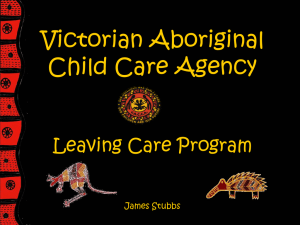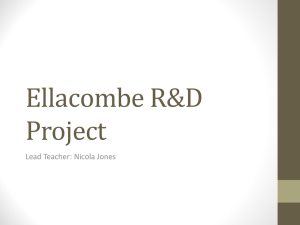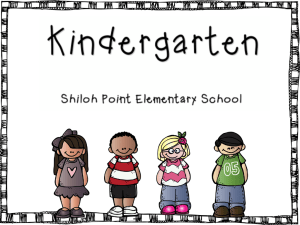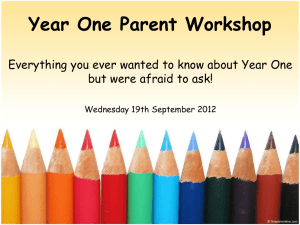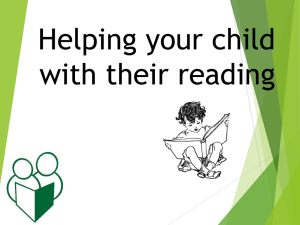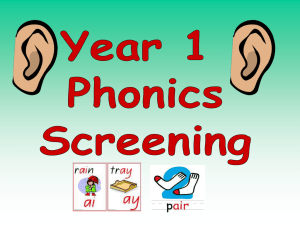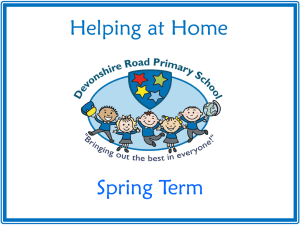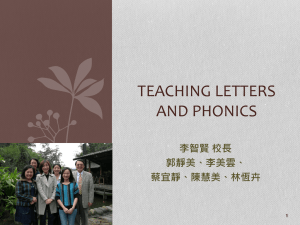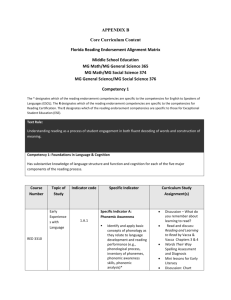Reading - Dawn of Education
advertisement
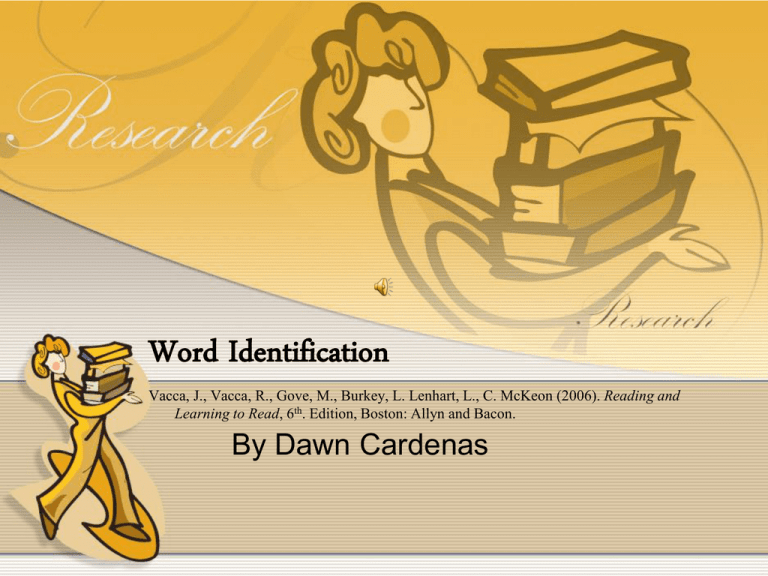
Word Identification Vacca, J., Vacca, R., Gove, M., Burkey, L. Lenhart, L., C. McKeon (2006). Reading and Learning to Read, 6th. Edition, Boston: Allyn and Bacon. By Dawn Cardenas Foniks Instrukshun: Between the Lines In this presentation, you will discover: •Phases of word identification. • Guidelines and strategies for teaching phonics. • Strategies for teaching words in context. • Strategies for teaching rapid recognition of words. • Guidelines for balancing word identification instruction. Vacca, J., Vacca, R., Gove, M., Burkey, L. Lenhart, L., C. McKeon (2006). Reading and Learning to Read, 6th. Edition, Boston: Allyn and Bacon. Opening Questions: • What combination of strategies, or cueing systems, do children need to use for immediate word recognition? • How can contemporary phonics guidelines inform your instruction? • How can word identification be taught as a part of a balanced literacy program? Key Terms Analogy-based instruction Analytic phonics Cross-checking Decodable text Onset Phonograms Rime Self-monitoring Embedded phonics instruction Spelling-based instruction High-frequency words Synthetic phonics Key words Word banks Linguistic instruction Word walls Vacca, J., Vacca, R., Gove, M., Burkey, L. Lenhart, L., C. McKeon (2006). Reading and Learning to Read, 6th. Edition, Boston: Allyn and Bacon. Vacca, J., Vacca, R., Gove, M., Burkey, L. Lenhart, L., C. McKeon (2006). Reading and Learning to Read, 6th. Edition, Boston: Allyn and Bacon. Developmental Phases in Children’s Ability to Read Words Prealphabetic phase (Remembering a distinctive, purely visual cue) Example: tall posts ye llow KitteN Partial alphabetic phase (Remembering limited matches between salient letter sounds) Example: matches between K and N only k it n C L O CK Full alphabetic phase (Remembering matches between all letters and sounds) Example: 4 letter units matched to 4 sound units k Consolidated alphabetic phase (Remembering matches between multiletter units and symbolic units) Example: matching onset and rime units l o CR ATE kr at Vacca, J., Vacca, R., Gove, M., Burkey, L. Lenhart, L., C. McKeon (2006). Reading and Learning to Read, 6th. Edition, Boston: Allyn and Bacon. k A Primer on the Content and Language of Phonics Terms of Phonics Definitions of Terms Examples of Terms Consonants All the sounds represented by letters of the alphabet except a, e, i, o, and u. Hard c: cat, coaster, catatonic (c sounds like /k/) Soft c: city, receive, cite (c sounds like /s/) Consonant Blends Two or three consonants grouped together, but each consonant retains its original sound. l blends: bl cl fl gl pl sl r blends: br cr dr fr gr pr tr s blends: sc sk sm sn sp st sw 3-letter blends: scr spr str Consonant Digraphs Two or more consonants are combined to produce a new sound. ch in chin ph in phone sh in shell gh in ghost th in think -nk in tank wh in whistle -ng in tang Phonograms Letter patterns that help to form word families or rhyming words. ad in bad, dad, fad, sad at in cat, hat, mat, sat ack in back, hack, jack, pack Vacca, J., Vacca, R., Gove, M., Burkey, L. Lenhart, L., C. McKeon (2006). Reading and Learning to Read, 6th. Edition, Boston: Allyn and Bacon. Continued A Primer on the Content and Language of Phonics Terms of Phonics Vowels Vowel Digraphs Vowel Diphthongs Consonant-Influenced Vowels Definitions of Terms Examples of Terms Short Sounds /a/ in Pat /e/ in bed /i/ in pit /o/ in hot /u/ in hug Long Sounds /a/ in lake /e/ in be /i/ in ice /o/ in go /u/ in use Two vowels that are adjacent to one another. The first vowel is usually long; the second vowel is silent. oa in boat ee in beet ea in beat ai in bait ay in bay oo in look ew in flew ea in read Sounds that consist of a blend of two separate vowel sounds. /oi/ in oil /oy/ in toy /au/ in taught /aw/ in saw /ou/ in out /ow/ in how All the sounds represented by letters a, e, i, o, and u. The letter a has a special sound l in Albert or tallow when followed by an l. R-controlled vowels occur r in star, her, fir, for, and purr when any vowel letter is followed by an r. Continued A Primer on the Content and Language of Phonics Syllable Patterns Types of Syllable Patterns Examples of Syllable Patterns Long Vowels CV Cve be like rote paid boat CVVC Short Vowels VC or CVC it hot R-controlled Vr CVr art car, her Digraph/Diphthong Variations VV saw, book boil, out Vacca, J., Vacca, R., Gove, M., Burkey, L. Lenhart, L., C. McKeon (2006). Reading and Learning to Read, 6th. Edition, Boston: Allyn and Bacon. Traditional Approaches to Phonics • Analytic Phonics Instruction • Synthetic Phonics Instruction • Linguistic Phonics Instruction Contemporary Approaches to Phonics • Analogy Based Instruction • Spelling Based Instruction • Embedded Based Instruction Guidelines for Contemporary Phonics Instruction • Needs to build on foundation of phonemic awareness • Must be integrated into a total reading program • Should focus on reading print rather than learning rules • Needs to include teaching of onsets and rimes • Needs to include spelling based strategies. Strategies • Consonant Based Strategies • Favorites Foods • Flip Books • Digraph Tongue Twisters • Analogy Based Strategies • Rimes and Nursery Rhymes • Hink Pinks, Hinky Pinkies • Word Building • Spelling Based Strategies • Word Banks • Word Walls • Have-A-Go Word-Building Strategy The word-building strategy begins with the identification of the specific rime pattern to be studied. If the rime ine was the focus, it would be presented in the following manner. 1. 3. Building words by adding the onset. Write ine on large chart paper or on the overhead. Ask students to supply different consonants to create the words mine, nine, line, and dine. As each word is written, carefully enunciate the beginning consonant and the rime and then the whole word. For example, mine would be m-, -ine, mine. Repeat the procedure for each new word formed. Attention may then be paid to the ine rime. Discussion may clarify the relationship between the long i and silent e. 2. Building words by adding the rime. To ensure that students have a clear understanding of the onset and rime, present the onset and have the students supply the rime. Write m and have the children tell what would be added to create the word mine. After adding the ine, say the word in parts, m-, -ine, and then as a whole. Point to each letter pattern as it is said. Selecting a model word. Choose a common word that easily illustrates the specific letter pattern. The ine rime can be shown with a picture of the number 9. Illustrations can be added to the children’s personal dictionaries or anyplace else that can be easily referenced. Vacca, J., Vacca, R., Gove, M., Burkey, L. Lenhart, L., C. McKeon (2006). Reading and Learning to Read, 6th. Edition, Boston: Allyn and Bacon. Word-Building Strategy 4. 5. Guided practice. Provide many opportunities for the students to practice using the letter pattern. Possibilities include sharing big books with the pattern, using magnetic letters on cookie sheets, writing words on mini-chalkboards, tumbling letter blocks to form words, or making flip books with the rime pattern. Application. Provide opportunities for students to read stories, poems, chants, and rhymes with the specific letter pattern. It may be helpful to keep a list of appropriate titles or copies of poems and rhymes in a binder or folder marked with rimes and letter patterns. Vacca, J., Vacca, R., Gove, M., Burkey, L. Lenhart, L., C. McKeon (2006). Reading and Learning to Read, 6th. Edition, Boston: Allyn and Bacon. How do we use meaning and lettersound information to identify words? • Strategies for teaching context • Cloze with or without choice given • Guessing Games • Reader-selected miscue strategy • Cross Checking and Self-Monitoring Strategies Monitoring an Unknown Word What do you do when you come to a word you don’t know? 1. 2. 3. 4. If you can’t figure it out, Don’t let the word bug you. Maybe you can understand the selection without it. Try to sound it out. If you can’t . . . Say “blank” and skip it. Read at least to the end of the sentence. Go back and look at the word and see if you can think of a word that makes sense and has these letters. Vacca, J., Vacca, R., Gove, M., Burkey, L. Lenhart, L., C. McKeon (2006). Reading and Learning to Read, 6th. Edition, Boston: Allyn and Bacon. What are some strategies for teaching rapid recognition of words? Strategies for Teaching High Frequency or Function Words • Language Experience Strategy • Word Walls • Environmental Print • Teaching Key Words • Classifying Words • Relating Words • Acting out words What are some guidelines for balancing word identification instruction? • No one-size-fits-all approach • Unlimited experiences with words in authentic texts • On-going, systematic, explicit phonics instruction using meaningful texts • Early development of sight word knowledge • Instruction in use of context clues A SMART Goal Using a thesaurus and a worksheet, children will read, make inferences, and draw conclusions from riddles with 80% or greater accuracy. Related Web Sites Starfall www.starfall.com. Where children have fun learning to read Summary of the International Reading Association Position Statement on Phonics www.reading.org/resources/issues/positions_phonics.html This bulleted summary synthesizes the position statement and provides a link for accessing the entire statement. Multnomah County Library www.multcolib.org/kids/fun.html This Web site has links to numerous games and activities about word study for all ages. The Dolch Kit www.theschoolbell.com/Links/Dolch/Dolch.html This Web site has links to online alphabet activities including a site for each letter of the alphabet for primary-age children. Four Blocks Literacy Framework: Word Wall Cheers k111.k12.il.us/lafayette/fourblocks/word_wall_chants.htm This Web site includes ideas and “cheers” for teaching spelling using word walls. References Florida Education Standards Commission (nd). Accomplished Competencies for Teachers of the Twenty-First Century. Retrieved July 2, 2007 from Florida Atlantic University, Blackboard Web site: http://blackboard.fau.edu/webapps/portal/frameset.jsp?tab=courses&url=/bin/common/cour se.pl?course_id=_60465_1 Vacca, J., Vacca, R., Gove, M., Burkey, L. Lenhart, L., C. McKeon (2006). Reading and Learning to Read, 6th. Edition, Boston: Allyn and Bacon. Answers to Questions & Key Terms Questions: • Children should be able to automatically identify words by using a combination of phonics, sight recognition, structural analysis and context strategies. • Children should be taught to identify words through explicit, systematic phonics instruction including onset and rime recognition as part of a total reading program. • By using an integrated approach to literacy including the early development of sight word knowledge and instruction in how to use context clues in a variety of texts. Key Terms: • Onset- The initial part of a word (a consonant, consonant blend, or digraph) that precedes the word. • Rime- The part of a letter pattern in a word that includes the vowel and any consonants that follow; also called a phonogram or a word family. • High frequency words- Words that appear often in printed material. Education Accomplished Practices 1. ASSESSMENT: • Assesses individual and group performance to design instruction that meets students' current needs in the cognitive, social, linguistic, cultural, emotional, and physical domains. 2. COMMUNICATION: • Motivates, encourages, and supports individual and group inquiry. 4. CRITICAL THINKING: • • • Analyzes student performance standards to identify associated higher-order thinking skills, and designs learning and performance strategies to evoke these higher-order skills. Poses problems, dilemmas, and questions in lessons that involve value knowledge and that require evaluative thinking. Monitors students’ work and adjusts strategies in response to learners’ needs and successes in creative thinking activities. 7. HUMAN DEVELOPMENT & LEARNING: • Makes appropriate provisions for individual students based upon their learning styles based on needs and developmental levels. 8. KNOWLEDGE OF SUBJECT MATTER: • Communicates accurate knowledge of subject matter in a comprehensible manner using language and style appropriate to the learner.
